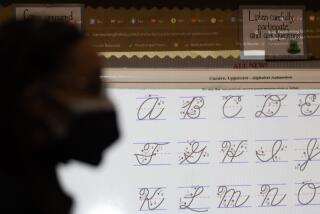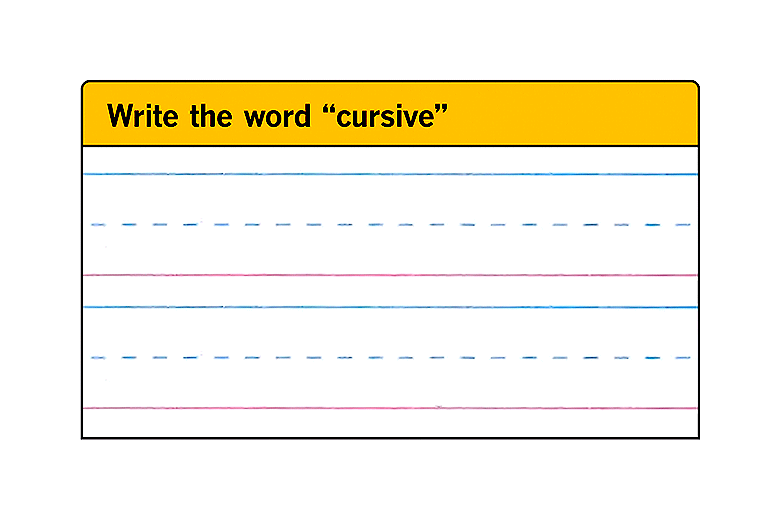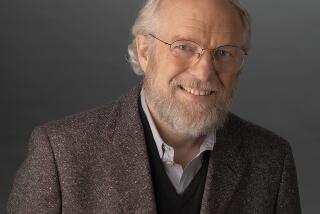Battle of the Typewriter Keyboards : Dvorak Design Offered as Alternative to QWERTY
Barbara Blackburn has made a name for herself with strikes.
And a job action is what it is, although not in the usual sense. When Blackburn is at an office typewriter, the company gets its moneyâs worth. She strikes the keyboard at a rate of 150 words a minute, which has earned her a place in the Guinness Book of World Records.
Not bad for someone who was dreadful in her high school typing class back in Pleasant Hill, Mo.
âI was in the running to be valedictorian of my class in 1938,â she recalled. âBut I couldnât even reach the required 50 words per minute in typing, and the grade that I received pulled my whole average down.â
She, as is the case with most typists today, was using the familiar QWERTY system, named for six letters on the left side of the keyboard.
âI donât know if I could even have gotten a job, much less be in the Guinness book, if it hadnât been for Dvorak,â Blackburn said.
That isnât on any row of keys. It is a special keyboard patented in 1936, little known and less used for decades, but now surging into popularity because of the emergence of personal computers. Is there life after QWERTY?
âStudies have shown that in an eight-hour day the fingers of a QWERTY typist travel 16 miles,â Virginia Russell said by phone from her home in Brandon, Vt. âThe fingers of a Dvorak typist go only one mile.â
Russell can make such statements because she is president of the Dvorak International Federation, described as a nonprofit organization devoted to promoting the maverick keyboard.
âPeople used to think of us as an Esperanto cult type of thing,â she said, referring to the international language. âBut of late I have been dealing with organizations such as the U. S. Department of Agriculture, the Social Security Administration, the Ford Motor Co. and several of the major insurance companies.â
OK, so what is this desecration of the sacred typing system we all know and love so well?
Typing machines have been around a long time. The first recorded patent of one was to a London engineer in 1714. The most famous one was issued in 1868 to three Milwaukee inventors--Carlos Glidden, Samuel Soule and Christopher Sholes.
âThe keyboard on their original patent was simply alphabetic,â Russell explained. âIn those days, though, everything was hunt and peck. And if a typist went too fast, the keys stuck.
âSholes developed about 25 alternate keyboards, but the one that caught on was QWERTY, which tended to lessen key-sticking.â
By the time touch-typing came on the scene decades later, after gun manufacturer E. Remington & Sons had put the word machine on the market, QWERTY was well entrenched as the keyboard to be taught.
âIn the early 1930s, however, August Dvorak and his brother-in-law, William Dealey, took a statistics course at Brown University,â Russell said. âThe teacher suggested to them that they look into the typewriter keyboard as it related to frequency of letter usage in the English language.â
Dvorak, a professor of education at the University of Washington, and Dealey, a professor of education at North Texas State University, got a grant from the Carnegie Foundation.
Until recently what they came up with as a result of their studies ranked right up there with Newton and his figs.
But the logic of the unconventional keyboard is flawless. On the home row, where the typistâs fingers are positioned, the left hand rests on the vowels A-O-E-U-I and the right hand on the frequently used consonants D-H-T-N-S.
âTen of the 13 most commonly used letters in the English language are on the home row of Dvorak, as opposed to three on the home row of the other system,â Russell said.
âThis means that 70% of the words regularly used in English can be typed on Dvorakâs home row, compared with 32% on QWERTY.
âNot only that, but we took 200,000 names from the Blue Cross-Blue Shield rolls and discovered that roughly the same percentages applied.â
Supporters of the alternate keyboard maintain that whereas it takes more than 50 hours of studying QWERTY to reach 40 words a minute (roughly 60 words per minute is required to become a secretary in most offices), it takes only 18 hours to attain 40 words a minute via Dvorak.
Little did the originator realize that years down the road was mass popularity of personal computers: With some of these, the flick of a switch can change the keyboard from the QWERTY to the Dvorak system. (If the typist chooses to do so, he or she can move interchangeable caps on the individual keys so that the letter corresponds to what is actually being typed.)
Owners such as executives having to use a keyboard for the first time are finding the Dvorak one easier to learn and more productive to use, Russell said.
âI went to the patent office and found that about 275 typewriter keyboards have been patented since 1870,â Russell said. âOnly two are still in any significant use.â
In 1975, the year that Dvorak died, one of his disciples made her first appearance in the Guinness book. Blackburn has been in it ever since.
The one-time problem student has become granny with the fast fingers.
âAfter I did so poorly with typing in high school, I went to a business college in Kansas City,â Blackburn said here last week while en route to the Winter Consumer Electronics Show in Las Vegas.
As an experiment, a couple of typewriters at the college had been converted to a new keyboard, and the student figured she had nothing to lose by trying to learn on one of them.
Within a year she was exceeding 90 words a minute. Now 64 years old, she has made a living at a typewriter ever since. She is currently in the Salem, Ore., office of an insurance company and goes on the road on behalf of software publisher Scarborough Systems.
Her record is maintaining 150 words a minute for 50 minutes (37,500 strokes). She said she recently reached 196 w.p.m., and is submitting that for the next edition.
All because, nearly half a century ago, someone did a little unlocking with a few keys.






